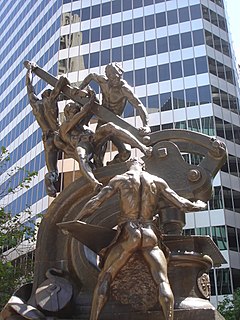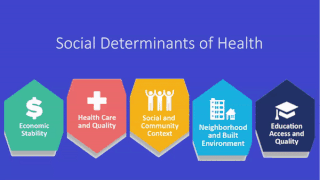It has been suggested that this article should be split into articles titled disadvantaged (disability) and disadvantaged (economics) . (discuss) (June 2022) |
The "disadvantaged" is a generic term for individuals or groups of people who:
It has been suggested that this article should be split into articles titled disadvantaged (disability) and disadvantaged (economics) . (discuss) (June 2022) |
The "disadvantaged" is a generic term for individuals or groups of people who:
In common usage "the disadvantaged" is a generic term for those "from lower-income backgrounds" or "the Disadvantaged Poor". [3] The "economically disadvantaged" is a term used by government institutions in for example allocating free school meals to "a student who is a member of a household that meets the income eligibility guidelines for free or reduced-price meals (less than or equal to 185% of Federal Poverty Guidelines)" [4] [5] or business grants. [6]
The "disadvantaged" is often applied in a third world context [ citation needed ] and typically relate to women with reduced "upward mobility" [3] suffering social exclusion and having limited access to natural resources and economic opportunities. [3] They are often landless or marginal farmers operating on the most unproductive land. [3]
According to Paul Krugman in an October 2002 article titled "about the distribution of wealth", [7] there is even more of a divide between the classes today than in the 1920s, meaning that the disadvantaged are becoming more economically disadvantaged.
Many governments use Disadvantaged area as a designation for various "problem" areas. In the UK "disadvantaged area" is a term used for an area where there is a need "to stimulate the physical, economic and social regeneration" by attracting development and encouraging the purchase of properties. [8] in special provisions for Stamp Tax relief [9] and for areas where health is an issue. [10] In the United States The "Nursing Relief for Disadvantaged Areas Act" [11] allowed qualifying hospitals to employ temporary foreign workers as Registered Nurses.

Poverty is the state of having few material possessions or little income. Poverty can have diverse social, economic, and political causes and effects. When evaluating poverty in statistics or economics there are two main measures: absolute poverty compares income against the amount needed to meet basic personal needs, such as food, clothing, and shelter; relative poverty measures when a person cannot meet a minimum level of living standards, compared to others in the same time and place. The definition of relative poverty varies from one country to another, or from one society to another.

The poverty threshold, poverty limit, poverty line or breadline is the minimum level of income deemed adequate in a particular country. The poverty line is usually calculated by estimating the total cost of one year's worth of necessities for the average adult. The cost of housing, such as the rent for an apartment, usually makes up the largest proportion of this estimate, so economists track the real estate market and other housing cost indicators as a major influence on the poverty line. Individual factors are often used to account for various circumstances, such as whether one is a parent, elderly, a child, married, etc. The poverty threshold may be adjusted annually. In practice, like the definition of poverty, the official or common understanding of the poverty line is significantly higher in developed countries than in developing countries.

Social class in the United States refers to the idea of grouping Americans by some measure of social status, typically economic. However, it could also refer to social status or location. The idea that American society can be divided into social classes is disputed, and there are many competing class systems.

There are wide varieties of economic inequality, most notably income inequality measured using the distribution of income and wealth inequality measured using the distribution of wealth. Besides economic inequality between countries or states, there are important types of economic inequality between different groups of people.
The basic needs approach is one of the major approaches to the measurement of absolute poverty in developing countries globally. It works to define the absolute minimum resources necessary for long-term physical well-being, usually in terms of consumption goods. The poverty line is then defined as the amount of income required to satisfy the needs of the people. The "basic needs" approach was introduced by the International Labour Organization's World Employment Conference in 1976. "Perhaps the high point of the WEP was the World Employment Conference of 1976, which proposed the satisfaction of basic human needs as the overriding objective of national and international development policy. The basic needs approach to development was endorsed by governments and workers' and employers' organizations from all over the world. It influenced the programmes and policies of major multilateral and bilateral development agencies, and was the precursor to the human development approach."
In economics, a cycle of poverty or poverty trap is caused by self-reinforcing mechanisms that cause poverty, once it exists, to persist unless there is outside intervention. It can persist across generations, and when applied to developing countries, is also known as a development trap.
Feminization of poverty refers to a trend of increasing inequality in living standards between men and women due to the widening gender gap in poverty. This phenomenon largely links to how women and children are disproportionately represented within the lower socioeconomic status community in comparison to men within the same socioeconomic status. Causes of the feminization of poverty include the structure of family and household, employment, sexual violence, education, climate change, femonomics and health. The traditional stereotypes of women remain embedded in many cultures restricting income opportunities and community involvement for many women. Matched with a low foundation income, this can manifest to a cycle of poverty and thus an inter-generational issue.

Poverty reduction, poverty relief, or poverty alleviation, is a set of measures, both economic and humanitarian, that are intended to permanently lift people out of poverty.

Social exclusion or social marginalisation is the social disadvantage and relegation to the fringe of society. It is a term that has been used widely in Europe and was first used in France in the late 20th century. It is used across disciplines including education, sociology, psychology, politics and economics.

The social determinants of health (SDOH) are the economic and social conditions that influence individual and group differences in health status. They are the health promoting factors found in one's living and working conditions, rather than individual risk factors that influence the risk for a disease, or vulnerability to disease or injury. The distributions of social determinants are often shaped by public policies that reflect prevailing political ideologies of the area.

Poverty in the United Kingdom refers to the portion of the population of the United Kingdom that are considered to be in poverty under some measures of poverty.

Poverty is measured in different ways by different bodies, both governmental and nongovernmental. Measurements can be absolute, which references a single standard, or relative, which is dependent on context. Poverty is widely understood to be multidimensional, comprising social, natural and economic factors situated within wider socio-political processes. The capabilities approach argues that capturing the perceptions of poor people is fundamental to understanding poverty.

Social inequality occurs when resources in a given society are distributed unevenly, typically through norms of allocation, that engender specific patterns along lines of socially defined categories of persons. It is the differentiation preference of access of social goods in the society brought about by power, religion, kinship, prestige, race, ethnicity, gender, age, sexual orientation, and class. Social inequality usually implies the lack of equality of outcome, but may alternatively be conceptualized in terms of the lack of equality of access to opportunity. The social rights include labor market, the source of income, health care, and freedom of speech, education, political representation, and participation.

In the United States, poverty has both social and political implications. In 2020, there were 37.2 million people in poverty. Some of the many causes include income inequality, inflation, unemployment, debt traps and poor education. The vast majority of people living in poverty are less educated and end up in a state of unemployment; higher incarceration rates have also been observed. Although the US is a relatively wealthy country by international standards, poverty has consistently been present throughout the United States, along with efforts to alleviate it, from New Deal-era legislation during the Great Depression, to the national war on poverty in the 1960s and poverty alleviation efforts during the 2008 Great Recession.

Below Poverty Line is a benchmark used by the government of India to indicate economic disadvantage and to identify individuals and households in need of government assistance and aid. It is determined using various parameters which vary from state to state and within states. The present criteria are based on a survey conducted in 2002. Going into a survey due for a decade, India's central government is undecided on criteria to identify families below poverty line.
Despite India's 50% increase in GDP since 2013, more than one third of the world's malnourished children live in India. Among these, half of the children under three years old are underweight.

The causes of poverty may vary with respect to nation, region, and in comparison with other countries at the global level. Yet, there is a commonality amongst these causes. Philosophical perspectives, and especially historical perspectives, including some factors at a micro and macro level can be considered in understanding these causes.

Hunger in the United States of America affects millions of Americans, including some who are middle class, or who are in households where all adults are in work. The United States produces far more food than it needs for domestic consumption—hunger within the U.S. is caused by some Americans having insufficient money to buy food for themselves or their families. Additional causes of hunger and food insecurity include neighborhood deprivation and agricultural policy. Hunger is addressed by a mix of public and private food aid provision. Public interventions include changes to agricultural policy, the construction of supermarkets in underserved neighborhoods, investment in transportation infrastructure, and the development of community gardens. Private aid is provided by food pantries, soup kitchens, food banks, and food rescue organizations.
Poverty in Norway had been declining from World War II until the Global Financial Crisis. It is now increasing slowly, and is significantly higher among immigrants from the Middle East and Africa. Before an analysis of poverty can be undertaken, the definition of poverty must first be established, because it is a subjective term. The measurement of poverty in Norway deviates from the measurement used by the OECD. Norway traditionally has been a global model and leader in maintaining low levels on poverty and providing a basic standard of living for even its poorest citizens. Norway combines a free market economy with the welfare model to ensure both high levels of income and wealth creation and equal distribution of this wealth. It has achieved unprecedented levels of economic development, equality and prosperity.
Fran Baum is an Australian social scientist who conducts research on the social and economic influences and determinants of health. She is director of the Southgate Institute of Health, Society and Equity at Flinders University, Australia, and became an Officer of the Order of Australia for her advocacy work on "improved access to community health care, and to professional organisations". In 2006, Baum was elected a Fellow of the Academy of the Social Sciences in Australia.
{{cite web}}: CS1 maint: archived copy as title (link)